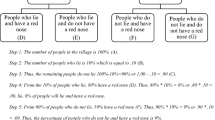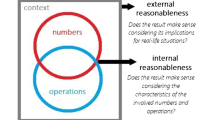Abstract
Students expose various intuitions in probability comparison and calculation tasks. Large volumes of research looked into these intuitions by categorizing learners’ strategies, but fewer studies considered how these intuitions may be associated with learners’ judgments. Even fewer examined the mixed effects of multiple intuitions held by the same individual. Despite calls from scholars to explore students’ understanding of probability in different cultural contexts, there has been a dearth of research on how Chinese students understand probability. This study explores the relationship between students’ multiple probability-related intuitions and their judgments in the probability contexts among middle school students in China. In this study, we sampled 707 7th–9th graders from Qingdao, China. We measured students’ performance in probability comparisons and calculations and their probability-related intuitions about equiprobability bias and representativeness heuristics. With chi-square tests and multinomial logistic regression analysis, the relationship between the 2 intuitions and students’ judgments in probability comparison and calculation tasks was examined in detail (including dual effects). The findings of this study include, first, that at the middle school level, students’ equiprobability bias and representativeness heuristics fade with age, but they do not disappear completely. Second, students’ intuitions may play a role in solving probability problems, where equiprobability bias may induce them to make an “equal probability” judgment and representativeness heuristics may make them consider a mixed outcome more likely to occur. Third, the 2 intuitions coexisted and influenced students’ responses together, but the sensitivity of these dual effects to the students’ judgments in the qualitative comparison and quantitative calculation tasks differed. This study will contribute to the fast-iterating policymaking in probability education in China by advocating that curriculum standards pay more attention to students’ limitations in conceptual understanding and their exposed intuitions or misconceptions. This study may, to some extent, complement previous works focusing on Western students’ probability intuitions by confirming that, even for Chinese students who performed well in PISA, their probability perceptions are also accompanied by intuitions.
Similar content being viewed by others
References
Ang, L. H., & Shahrill, M. (2014). Identifying students’ specific misconceptions in learning probability. International Journal of Probability and Statistics, 3(2), 23–29.
Arican, M., & Kuzu, O. (2020). Diagnosing preservice teachers’ understanding of statistics and probability: Developing a test for cognitive assessment. International Journal of Science and Mathematics Education, 18, 771–790.
Baltaci, S. (2016). Examination of gifted students’ probability problem solving process in terms of mathematical thinking. Malaysian Online Journal of Educational Technology, 4(4), 18–35.
Batanero, C., & Sanchez, E. (2005). What is the nature of high school students’ conceptions and misconceptions about probability? In G. A. Jones (Ed.), Exploring Probability in School (pp. 241–266). Springer.
Batanero, C., Arteaga, P., Serrano, L., & Ruiz, B. (2014). Prospective primary school teachers’ perception of randomness. In E. Chernoff & B. Sriraman (Eds.), Probabilistic Thinking (pp. 345–366). Springer.
Batista, R., Borba, R., & Henriques, A. (2022). Fairness in games: A study on children’s and adults’ understanding of probability. Statistics Education Research Journal, 21(1), 13–13.
Begolli, K. N., Dai, T., McGinn, K. M., & Booth, J. L. (2021). Could probability be out of proportion? Self-explanation and example-based practice help students with lower proportional reasoning skills learn probability. Instructional Science, 49(4), 441–473.
Bryant, P., & Nunes, T. (2012). Children’s understanding of probability: A literature review (full report). The Nuffield Foundation.
Cai, S., Liu, E., Shen, Y., Liu, C., Li, S., & Shen, Y. (2020). Probability learning in mathematics using augmented reality: Impact on student’s learning gains and attitudes. Interactive Learning Environments, 28(5), 560–573.
Chen, C., Sonnert, G., Sadler, P. M., Sasselov, D., & Fredericks, C. (2020). The impact of student misconceptions on student persistence in a MOOC. Journal of Research in Science Teaching, 57(6), 879–910.
Chernoff, E. J., & Sriraman, B. (2020). Heuristics and biases. In S. Lerman (Ed.), Encyclopedia of mathematics education (pp. 327–330). Springer, Cham.
Chernoff, E. J., Mamolo, A., & Zazkis, R. (2016). An investigation of the representativeness heuristic: The case of a multiple choice exam. Eurasia Journal of Mathematics, Science and Technology Education, 12(4), 1009–1031.
Chernoff, E. J., Vashchyshyn, I., & Neufeld, H. (2018). Comparing the relative probabilities of events. In C. Batanero & E. Chernoff (Eds.), Teaching and learning stochastics (pp. 277–291). ICME-13 monographs. Springer, Cham.
China Ministry of Education. (2022). Mathematics curriculum standards for compulsory education (2022nd ed.). Beijing Normal University Press. [In Chinese].
Eisinga, R., Grotenhuis, M. T., & Pelzer, B. (2013). The reliability of a two-item scale: Pearson, Cronbach, or Spearman-Brown? International Journal of Public Health, 58, 637–642.
Engel, J., & Sedlmeier, P. (2005). On middle-school students’ comprehension of randomness and chance variability in data. ZDM Mathematics Education, 37(3), 168–177.
Erbas, A. K., & Ocal, M. F. (2022). Students’ intuitively-based (mis)conceptions in probability and teachers’ awareness of them: The case of heuristics. International Journal of Mathematical Education in Science and Technology. https://doi.org/10.1080/0020739X.2022.2128454
Falk, R., & Lann, A. (2008). The allure of equality: Uniformity in probabilistic and statistical judgment. Cognitive Psychology, 57(4), 293–334.
Fischbein, E. (1987). Intuition in science and mathematics: An educational approach. Reidel.
Fischbein, E., & Gazit, A. (1984). Does the teaching of probability improve probabilistic intuitions? Educational Studies in Mathematics, 15(1), 1–24.
Fischbein, E., & Schnarch, D. (1997). Brief report: The evolution with age of probabilistic, intuitively based misconceptions. Journal for Research in Mathematics Education, 28(1), 96–105.
Fox, C. R., & Rottenstreich, Y. (2003). Partition priming in judgment under uncertainty. Psychological Science, 14(3), 195–200.
Gal, I. (2005). Towards “probability literacy” for all citizens: Building blocks and instructional dilemmas. In G. A. Jones (Ed.), Exploring probability in school (pp. 39–63). Springer.
Garfield, J. B., & Ahlgren, A. (1988). Difficulties in learning basic concepts in probability and statistics: Implications for research. Journal for Research in Mathematics Education, 19(1), 44–63.
Gauvrit, N., & Morasnyi, K. (2014). Equiprobability bias from a mathematical and psychological perspective. Advances in Cognitive Psychology, 10(4), 119–130.
González-Forte, J. M., Fernández, C., Van Hoof, J., & Van Dooren, W. (2023). Incorrect ways of thinking about the size of fractions. International Journal of Science and Mathematics Education, 21(7), 2005–2025.
Gong, Z., & He, S. (2017). Developmental stages and important periods of probability cognition in 6 to 14 year-old students. Avances de Investigación en Educación Matemática, 11, 47–68.
Gualtieri, S., & Denison, S. (2018). The development of the representativeness heuristic in young children. Journal of Experimental Child Psychology, 174, 60–76.
Hawkins, A. S., & Kapadia, R. (1984). Children’s conception of probability: A psychological and pedagogical review. Educational Studies in Mathematics, 15, 349–377.
Hokor, E. K., Apawu, J., Owusu-Ansah, N. A., & Agormor, S. (2022). Preservice teachers’ misconceptions in solving probabilistic problems. Pedagogical Research, 7(1), em0112.
Jafer, Y. J. (2020). Assessing Kuwaiti pre-service science teachers’ greenhouse effect perceptions and misconceptions. International Journal of Science and Mathematics Education, 18(4), 657–667.
Jones, G. A., & Thornton, C. A. (2005). An overview of research into the teaching and learning of probability. In G. A. Jones (Ed.), Exploring probability in school (pp. 65–92). Springer.
Jones, G. A., Langrall, C. W., & Mooney, E. S. (2007). Research in probability: Responding to classroom realities. In F. K. Lester (Ed.), Second handbook of research on mathematics teaching and learning: A project of the National Council of Teachers of Mathematics (pp. 909–955). Information Age Publishing.
Kahneman, D., & Tversky, A. (1972). Subjective probability: A judgment of representativeness. Cognitive Psychology, 3(3), 430–454.
Kaplar, M., Lužanin, Z., & Verbić, S. (2021). Evidence of probability misconception in engineering students—why even an inaccurate explanation is better than no explanation. International Journal of STEM Education, 8(1), 1–15.
Konold, C. (1989). Informal conceptions of probability. Cognition and Instruction, 6(1), 59–98.
Lecoutre, M. P. (1992). Cognitive models and problem spaces in “purely random” situations. Educational Studies in Mathematics, 23(6), 557–568.
Li, J. (2000). Chinese students’ understanding of probability [Unpublished doctoral dissertation]. Nanyang Technological University.
Lin, Q. (2013). Textbook of mathematics for compulsory education (Grade 9, Book 1, pp. 136–140). People’s Education Press. [in Chinese].
McDonald, R. P. (1999). Test theory: A unified treatment. Eribaum.
Mistele, J. M. (2014). Exploring middle school students’ heuristic thinking about probability. Unpublished doctoral dissertation. Virginia Polytechnic Institute and State University.
Molnar, A. (2018) Language and lexical ambiguity in the probability register. In C. Batanero & E. Chernoff (Eds.), Teaching and learning stochastics (pp. 23–37). ICME-13 Monographs. Springer, Cham.
Morsanyi, K., & Szücs, D. (2015). Intuition in mathematical and probabilistic reasoning. In R. Kadosh & A. Dowker (Eds.), Oxford handbook of numerical cognition (pp. 180–200). Oxford University Press.
Morsanyi, K., Primi, C., Chiesi, F., & Handley, S. J. (2009). The effects and side-effects of statistics education: Psychology students’ (mis-)conceptions of probability. Contemporary Educational Psychology, 34, 210–220.
Morsanyi, K., Handley, S. J., & Serpell, S. (2013). Making heads or tails of probability: An experiment with random generators. British Journal of Educational Psychology, 83(3), 379–395.
Myers, D. G. (2002). Intuition: Its powers and perils. Yale University Press.
Nikiforidou, Z., Pange, J., & Chadjipadelis, T. (2013). Intuitive and informal knowledge in preschoolers’ development of probabilistic thinking. International Journal of Early Childhood, 45(3), 347–357.
Nilsson, P., & Li, J. (2015). Teaching and learning of probability. In S. J. Cho (Ed.), The proceedings of the 12th international congress on mathematical education (pp. 437–442). Springer, Cham.
Park, M., & Lee, E. J. (2019). Korean preservice elementary teachers’ abilities to identify equiprobability bias and teaching strategies. International Journal of Science and Mathematics Education, 17, 1585–1603.
Paul, M., & Hlanganipai, N. (2014). The nature of misconceptions and cognitive obstacles faced by secondary school mathematics students in understanding probability: A case study of selected Polokwane secondary schools. Mediterranean Journal of Social Sciences, 5(8), 446–455.
Polaki, M. V. (2002). Using instruction to identify key features of Basotho elementary students’ growth in probabilistic thinking. Mathematical Thinking and Learning, 4(4), 285–313.
Potvin, P., & Cyr, G. (2017). Toward a durable prevalence of scientific conceptions: Tracking the effects of two interfering misconceptions about buoyancy from preschoolers to science teachers. Journal of Research in Science Teaching, 54(9), 1121–1142.
Potvin, P., Malenfant-Robichaud, G., Cormier, C., & Masson, S. (2020). Coexistence of misconceptions and scientific conceptions in chemistry professors: A mental chronometry and fMRI study. Frontiers in Education, 5, 542458.
Pretz, J. E., Brookings, J. B., Carlson, L. A., Humbert, T. K., Roy, M., Jones, M., & Memmert, D. (2014). Development and validation of a new measure of intuition: The types of intuition scale. Journal of Behavioral Decision Making, 27(5), 454–467.
Rubel, L. H. (2007). Middle school and high school students’ probabilistic reasoning on coin tasks. Journal for Research in Mathematics Education, 38(5), 531–556.
Salimpour, S., Tytler, R., Doig, B., Fitzgerald, M. T., & Eriksson, U. (2023). Conceptualising the cosmos: Development and validation of the cosmology concept inventory for high school. International Journal of Science and Mathematics Education, 21(1), 251–275.
Sedlmeier, P. (2007). Statistical reasoning: Valid intuitions put to use. In C. M. C. Lovett, & P. Shah (Eds.), Thinking with data (pp. 389–419). Psychology Press.
Shaughnessy, J. M. (1992). Research on probability and statistics: Reflections and directions. In D. A. Grouws (Ed.), Handbook of research on mathematical teaching and learning (pp. 465–494). Macmillan.
Stohl, H. (2005). Probability in teacher education and development. In G. A. Jones (Ed.), Exploring probability in school (pp. 345–366). Springer.
Talanquer, V. (2009). On cognitive constraints and learning progressions: The case of “structure of matter.” International Journal of Science Education, 31(15), 2123–2136.
Tirosh, D., & Tsamir, P. (2020). Intuition in mathematics education. In S. Lerman (Ed.), Encyclopedia of mathematics education (pp. 428–433). Springer, Cham.
Tversky, A., & Kahneman, D. (1974). Judgment under uncertainty: Heuristics and biases. Science, 185(4157), 1124–1131.
Vahey, P., Enyedy, N., & Gifford, B. (2000). Learning probability through the use of a collaborative, inquiry-based simulation environment. Journal of Interactive Learning Research, 11(1), 51–84.
Watson, J. M., & Kelly, B. A. (2009). Development of student understanding of outcomes involving two or more dice. International Journal of Science and Mathematics Education, 7(1), 25–54.
Xu, B., Zhu, Y., & Lu, X. (Eds.). (2021). Beyond Shanghai and PISA: Cognitive and non-cognitive competencies of Chinese students in mathematics. Springer.
Yang, D. C., & Sianturi, I. A. J. (2021). Sixth grade students’ performance, misconception, and confidence on a three-tier number sense test. International Journal of Science and Mathematics Education, 19(2), 355–375.
Zhang, Z. X., Chen, C. C., Liu, L. A., & Liu, X. F. (2008). Chinese traditions and Western theories: Influences on business leaders in China. In C. C. Chen & Y. Ting. Lee (Eds.), Leadership and management in China: Philosophies, theories, and practices (pp. 239–271). Cambridge University Press.
Acknowledgements
We sincerely appreciate the tremendous help from Ms. Zhijun An of Qingdao Institute of Educational Science in the data collection for this study.
Funding
This work was sponsored by Humanities and Social Science Research Youth Fund Project of Chinese Ministry of Education (23YJC880034).
Author information
Authors and Affiliations
Corresponding author
Ethics declarations
Ethics Approval and Consent to Participate
The content, purpose, and process of this research were clarified to the Academic Ethics Committee of Shanghai Normal University, and this research was approved by the Academic Ethics Committee with approval number 2023004 (Ethical Approval of Shanghai Normal University). The purpose of this research was clarified to those involved, and they were informed that the data collected would be used for research purposes only. Those involved consented to participate in the study.
Conflict of Interest
The authors declare no competing interests.
Rights and permissions
Springer Nature or its licensor (e.g. a society or other partner) holds exclusive rights to this article under a publishing agreement with the author(s) or other rightsholder(s); author self-archiving of the accepted manuscript version of this article is solely governed by the terms of such publishing agreement and applicable law.
About this article
Cite this article
He, S., Chen, C. The Effects of Equiprobability Bias and Representativeness Heuristics on the Performance in Probability Comparison and Calculation Tasks Among Middle School Students in China. Int J of Sci and Math Educ (2024). https://doi.org/10.1007/s10763-024-10464-4
Received:
Accepted:
Published:
DOI: https://doi.org/10.1007/s10763-024-10464-4




